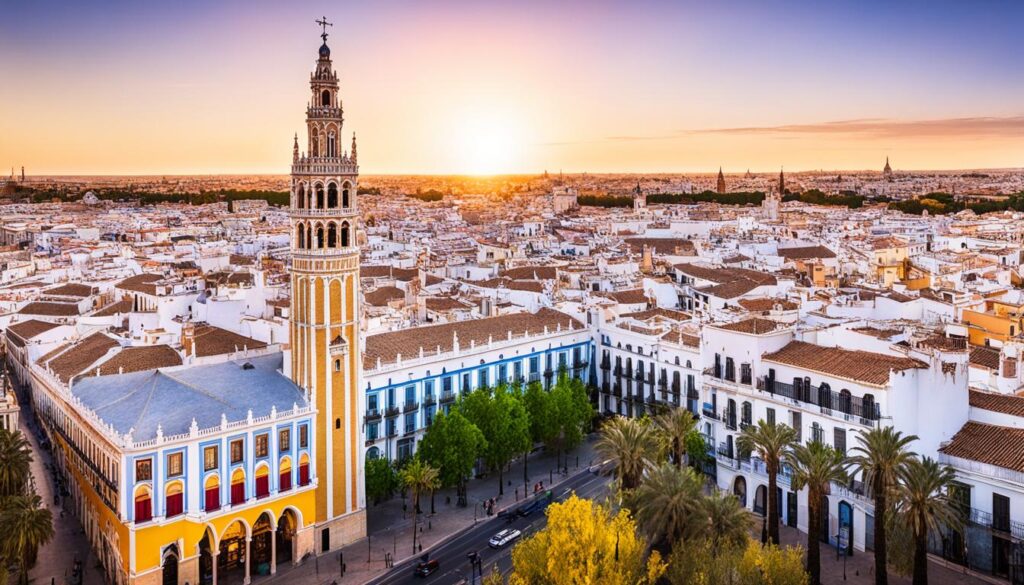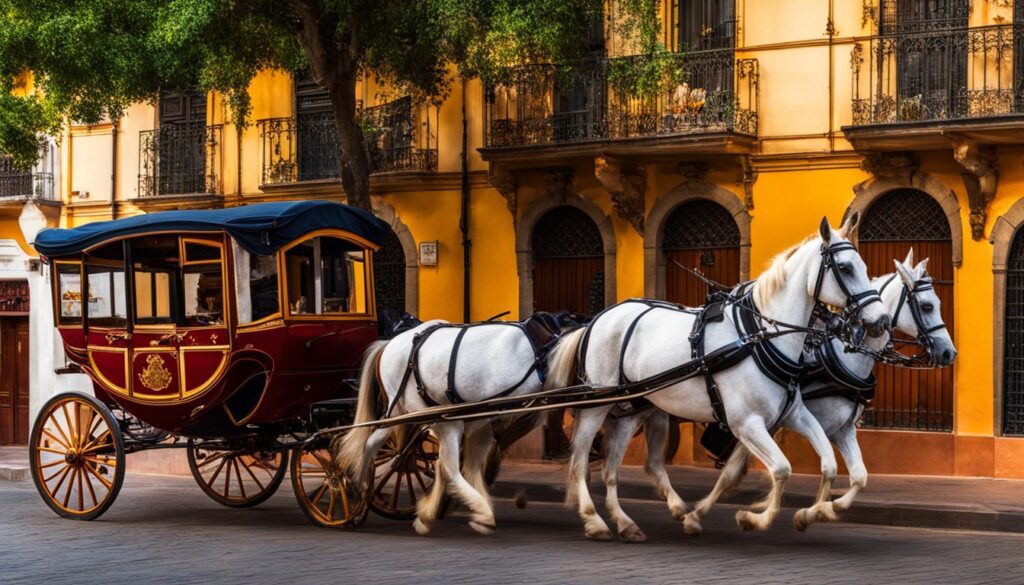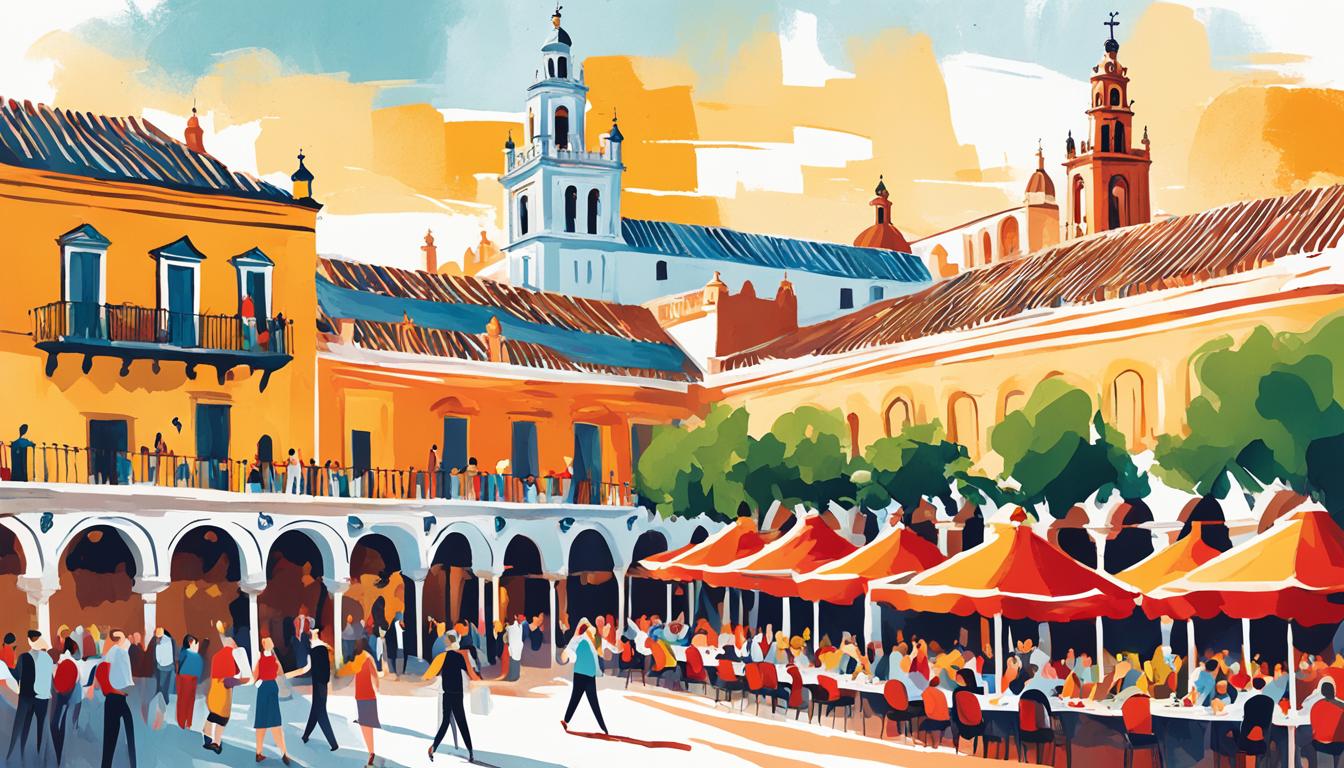Seville, the heart of Spain’s Andalucía, is alive with history, culture, and energy. It’s famous for its beautiful Moorish and Gothic buildings, lively flamenco music, and tasty tapas. Visitors can dive into Spanish traditions by exploring the Royal Alcázar and Seville Cathedral, tasting local foods, and enjoying flamenco’s soulful rhythms.
Key Takeaways
- Discover Seville’s rich Moorish and Gothic architectural heritage
- Immerse yourself in the passionate world of Flamenco, a UNESCO-recognized tradition
- Savor the delectable tapas cuisine that defines Andalusian culinary delights
- Explore the vibrant Barrio Santa Cruz and its hidden plazas and local artisans
- Witness the grand celebrations of Semana Santa (Holy Week) in Seville
Unveiling Sevilla’s Rich Heritage
Seville’s culture is filled with centuries of history. From the stunning moorish architecture of the Royal Alcázar to the huge Seville Cathedral, where Christopher Columbus‘s tomb is. This city invites you to explore its past and dive into the mix of Moorish, Gothic, and Spanish styles.
The Royal Alcázar: A Moorish Architectural Marvel
The Royal Alcázar, a UNESCO World Heritage site, shows off Seville’s Moorish past. Built in the 11th century, it has beautiful tilework, gardens, and a story that links to the Age of Discovery. This palace was where famous explorers like Columbus, Magellan, and Vespucci planned their journeys.
Catedral de Sevilla: Gothic Grandeur and Christopher Columbus’ Tomb
The Seville Cathedral stands tall over the city. It’s the biggest Gothic cathedral in the world and a true wonder. Here, you can see its high spires, beautiful facades, and the tomb of Christopher Columbus. After his trips across the Atlantic, he was buried here.
“The Seville Cathedral is a breathtaking display of Gothic grandeur, with intricate details and a sense of timeless elegance that transports visitors to another era.”
Plaza de España: A Stunning Showcase of Spanish Provinces
Visit the famous Plaza de España in Seville, a massive square with intricate tilework. It shows off Spain’s 48 provinces. Each province has a scene from a key event, a famous monument, and a map. This makes a beautiful picture of Spain’s diversity.
Exploring the Ornate Tilework and Fountains
See the amazing ornate tilework and architecture of the semi-circular building. It’s 170 meters wide and has four bridges. These bridges stand for the old kingdoms of Spain: Castile, León, Aragón, and Navarra.
At the plaza’s center, the fountains by Vicente Traver add beauty and coolness. Visitors can take a 515-meter boat ride on the canal. This ride symbolizes Spain’s history with its colonies.
You can rent rowing boats for up to four people or motorized boats for up to 12. These are available from 10:00 AM to 10:00 PM in summer and until 8:00 PM in winter.
Tranquility in María Luisa Park
Right next to the Plaza de España, the big María Luisa Park is a peaceful place. Walk through the greenery, smell the flowers, and see the fountains. Or, rent a rowboat to float on the calm canal.
The park also has important places like the Museum of Arts and Traditions and the Archaeological Museum.
The Plaza de España was even in Star Wars Episode II: Attack of the Clones. It became the city of Naboo. Built for the Ibero-American Exposition of 1929, it’s a key spot for seeing Seville’s culture.
sevilla culture: Flamenco’s Passionate Heartbeat
Dive into the world of flamenco, a key part of Seville’s lively culture. This art form, with its deep singing, lively guitar, and captivating dance, is Seville’s soul. See a live show in a cozy flamenco bar to feel the raw emotion and energy it brings.
Learn about flamenco‘s history and growth at the Flamenco Museum in Seville. You’ll see different styles and learn why UNESCO calls it a Masterpiece of the Oral and Intangible Heritage of Humanity.
Flamenco reaches far and wide, showing its global appeal. It thrives in places like Japan and the U.S., blending with other music to win over fans everywhere.
Seville’s flamenco legacy lives on through stars like Carmen Amaya and Paco de Lucía. New talents like Sara Baras and Vicente Amigo are also making their mark. They keep flamenco alive and vibrant, thanks to schools and festivals in Seville.
https://www.youtube.com/watch?v=ax4LPrUaXRY
“Flamenco is not just a dance; it’s a way of life, a language of the soul.”
Wandering the Charming Barrio Santa Cruz
In the heart of Seville lies the historic Barrio Santa Cruz. It’s a place of enchanting narrow streets. After the city was conquered in 1248, this area became home to the Jewish community. Today, it shows off its rich culture with beautiful plazas, hidden spots, and the work of local artisans.
Discovering Hidden Plazas and Local Artisans
Walking through Barrio Santa Cruz, you’ll find hidden plazas that offer a quiet break from the busy city. The Murillo Gardens are a peaceful spot for families and visitors. If you keep exploring, you’ll see the area’s artisan side. Here, local artists show off their skills in workshops and galleries.
- Explore the charming Plaza de Doña Elvira, a picturesque square lined with historic buildings
- Visit the Casa de la Guitarra, where you can witness the art of flamenco guitar making
- Discover the Archivo General de Indias, a 16th-century building that houses an impressive archive of Spain’s colonial history
The Barrio Santa Cruz is a place full of history and culture. It’s a spot you must visit to feel the real Seville. Its streets will enchant you with their timeless beauty.
“The Barrio de Santa Cruz in Seville is known for its narrow streets, colorful buildings, and lively atmosphere, making it one of the most beautiful historic urban spaces in Spain.”
A Tapas Tour: Savoring Seville’s Culinary Delights
Seville, the heart of Andalusia, is a top spot for tapas cuisine. Join us on a delicious journey through the city. We’ll visit lively bars, enjoying a mix of Spanish cuisine and Andalusian food favorites.
Begin at Plaza del Triunfo, home to the famous Inmaculada’s statue. Look for a guide with a purple or orange umbrella. They’ll lead you to Seville’s best local restaurants and traditional dishes.
- Try the amazing jamón ibérico, a cured ham that’s simply divine.
- Enjoy the crispy fried sardines, a favorite in Andalusia.
- Indulge in the tasty calamari, a key part of Spanish food.
- Love the spicy patatas bravas, crispy potatoes with a kick.
- Enjoy the perfect mix of crusty bread and olives.
- Refresh with a glass of sangria, Spain’s famous drink.
- Finish with the classic churros, dipped in rich chocolate.
As you move from bar to bar, take in the vibrant atmosphere. Embrace the culinary culture that makes Seville a top spot for food lovers. This tapas tour is a great way to experience Seville’s food heritage.
Whether you love food or are just curious, a Seville tapas tour is a must. It will delight your senses and make you want more of this city’s tasty offerings.
Setas de Sevilla: A Modern Marvel
The Setas de Sevilla, or “Mushrooms of Seville,” stands tall in the city’s historic center. It’s a mix of modern architecture and Seville’s rich culture. Built in 2011, it’s the biggest of its kind, reaching 30 meters (almost 100 feet) high.
German architect Jürgen Mayer designed this architectural wonder. It has a unique design with wooden panels that look amazing. The structure is more than just a sight. It has a market, restaurants, a performance area, a museum, and a rooftop with great views of Seville.
Visitors can take an elevator to the top for a light show at night. This show makes the place magical. The project’s cost went from €86 million to about €100 million. This shows the quality and innovation of the design.
“The Setas de Sevilla is a testament to the city’s commitment to preserving its cultural heritage while embracing the bold and innovative in modern architecture.”
Visiting the Setas de Sevilla is a must for those in Seville. It shows how metropol parasol, modern architecture, and rooftop views come together in this beautiful city.

Embracing Tradition: Sevilla’s Bullring
In the heart of Seville, the Plaza de Toros de la Real Maestranza de Caballería de Sevilla is a symbol of the city’s deep cultural roots. This famous plaza de toros, or bullring, has been around since the 18th century. It lets visitors see the beauty and traditions of bullfighting.
Exploring the History and Artistry of Bullfighting
Walk into the grand arena to discover its rich history. The Spanish traditions of bullfighting are alive here. A tour of the bullring’s museum helps you understand the sport’s importance and how it has changed over time.
The bullring’s design is a sight to behold, with its detailed Baroque style. The main entrance, the Prince’s Gate, has beautiful black iron gates made by Pedro Roldan. These gates add to the arena’s cultural heritage.
“Bullfighting is not a sport. It’s a tragedy in which the bull is the victim.”
– Marty Reisman
The debate on bullfighting is ongoing, but the Plaza de Toros de la Real Maestranza de Caballería de Sevilla lets you learn and dive into this Spanish tradition. Discover the history, beauty, and importance of this practice that has wowed people for centuries.
Crossing the Triana Bridge to a Vibrant Neighborhood
Walk across the famous Triana Bridge over the Guadalquivir River to enter Seville’s lively Triana neighborhood. This area is famous for its pottery and ceramics. It shows you the real local culture.
As you walk by the river, enjoy the beautiful views of the Torre del Oro. This 13th-century tower watches over the river. Triana is full of life with its tapas bars, shops, and bakeries. You’ll find delicious food and unique crafts here.
Visit the Centro de la Cerámica Triana to learn about the area’s pottery and ceramics. Keep an eye out for flamenco shows. They show Triana’s deep cultural roots.
| Triana Neighborhood Highlights | Comparisons |
|---|---|
|
|
Triana is perfect for those wanting real local experiences or to dive into Seville’s culture. It’s a place where you can feel the heart of Spain. Discover the traditions that make it a favorite spot for both visitors and locals.
“Triana is almost a miniature city within Seville, where you can find the quintessential Spanish experience.”
The Romance of Horse-Drawn Carriage Rides
Make your Seville trip special with a romantic horse-drawn carriage ride through the historic center. These carriages, near the Seville Cathedral, bring a touch of old-world charm to your visit. They make exploring Seville’s streets and landmarks unforgettable.
Seville’s horse-drawn carriages are a symbol of its culture and traditions. They’re seen in big events and celebrations. As you ride, you’ll see the beautiful details of these vehicles. You’ll pass by the Royal Alcázar, Plaza de España, and the Guadalquivir River.
- Learn about Seville’s history and architecture from the carriage drivers.
- Take great photos with the carriages and their beautiful settings.
- Enjoy the romantic feel of Seville at a slow pace.
Seville has more to offer, like flamenco shows and tours of famous landmarks. Whether you’re a couple or a family, a horse-drawn carriage ride is a magical way to make memories in this lively city.
| Experience | Duration | Price |
|---|---|---|
| Horse-Drawn Carriage Ride | 45 minutes | €84.16 per group of up to 4 people |
| Flamenco Show at Tablao Flamenco Las Setas | 1 hour | €35 per person |
| Guided Tour of Cathedral, Giralda, and Royal Alcázar | 2.5 hours | €45 per person |

“The horse-drawn carriage ride was the highlight of our trip to Seville. It was a truly magical and romantic experience that allowed us to see the city’s iconic landmarks in a unique and leisurely way.”
University of Seville: Historic Architectural Gem
Visit the University of Seville, one of Spain’s oldest and top universities. Marvel at the Royal Tobacco Factory, an 18th-century building now used for university offices and departments. This Baroque and Neoclassical structure shows Seville’s history and its role in education.
The University of Seville was founded in 1505 and sits in the historic city center. It’s surrounded by Moorish, Gothic, and Renaissance buildings. The Royal Tobacco Factory, built in the 18th century for tobacco production, now serves the university. It mixes Seville’s industrial history with its lively education scene.
Walking through the university, you’ll see stunning historic architecture at the royal tobacco factory. The Baroque and Neoclassical styles, with their detailed facades and inside decorations, show Seville’s cultural richness. They also highlight the city’s dedication to education and preserving its architectural gems.
| Architectural Style | Notable Features |
|---|---|
| Baroque | Ornate, highly decorative facades with intricate carvings and sculptural elements |
| Neoclassical | Symmetrical, grand entrances and courtyards with columns and pediments |
The University of Seville’s historic university of seville architecture and its long history make it a special place to visit. As you walk through, you’ll feel like you’ve stepped back in time. Here, learning meets the beauty of Seville’s architectural wonders.
Discovering Andalusian Heritage in Seville’s Surroundings
Seville sits in the heart of the Andalusia region, making it easy to explore cultural and natural wonders. You can visit the beautiful white villages on the hills, see the lovely coastal towns by the Atlantic and Mediterranean, and find peace in the mountain towns. These places show off the rich heritage and beauty of Andalusia, Spain.
The Andalusia region is famous for its deep cultural roots, thanks to over 800 years of Moorish rule. This history is seen in its buildings, art, and traditions. It’s a mix of Eastern and Western cultures. Places like the Alcázar in Seville and the Alhambra in Granada show off Moorish design that amazes everyone.
The countryside of Andalusia is full of its own charm. The white villages, or Pueblos Blancos, are in the hills and show the traditional life here. These towns, with their white buildings and narrow streets, keep the local culture alive. The Sierra de Grazalema Natural Park is a place of stunning nature that has inspired many artists and writers.
The coastal towns like Cádiz and Málaga are a world away from the inland villages. They mix history, architecture, and food in a unique way. You can walk through old streets, see amazing cathedrals, and try the fresh seafood that locals love.
If you want a calm experience, try the mountain towns of Andalusia, like Ronda and Grazalema. These towns are high up and surrounded by nature. They invite you to enjoy the quiet, explore nature, and feel the peaceful life of Andalusia.
Seville’s area is full of things to see, from beautiful buildings to traditional villages and stunning coasts. It’s a place where culture and nature come together. Discover the beauty and heritage of Andalusia, a special part of Spain.
“Andalucía is a land of contrasts, where the past and present coexist in perfect harmony, creating a tapestry of culture, tradition, and natural beauty that is truly captivating.” – Lonely Planet
Conclusion
Seville is a true gem of Spain, known for its Sevilla culture, Spanish traditions, and Andalusian experiences. The city is filled with grand architecture and the soulful sounds of flamenco. It offers a deep dive into Spanish life.
If you love history, the arts, or just great food, Seville will impress you. Its charming areas, beautiful squares, and friendly people make it unforgettable. You’ll want to come back again and again.
As you leave Seville, remember the Alcázar, the Catedral de Sevilla, the Plaza de España, and the flamenco rhythms. Seville’s heritage, culture, and spirit capture the heart of Spain. It’s a place that leaves a lasting impression on everyone who visits.

